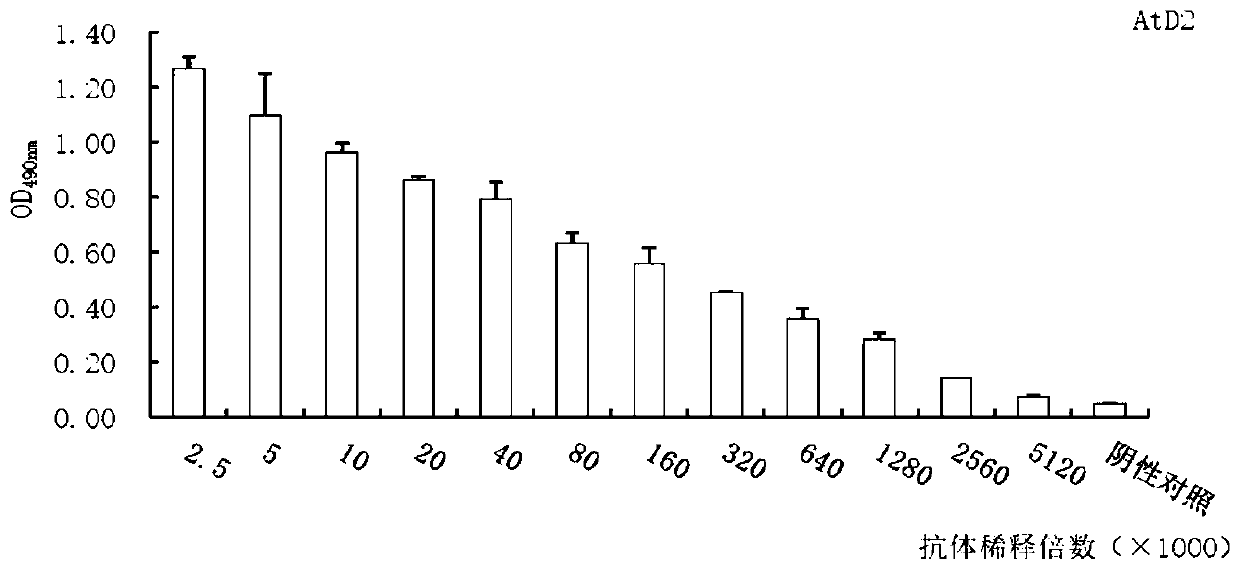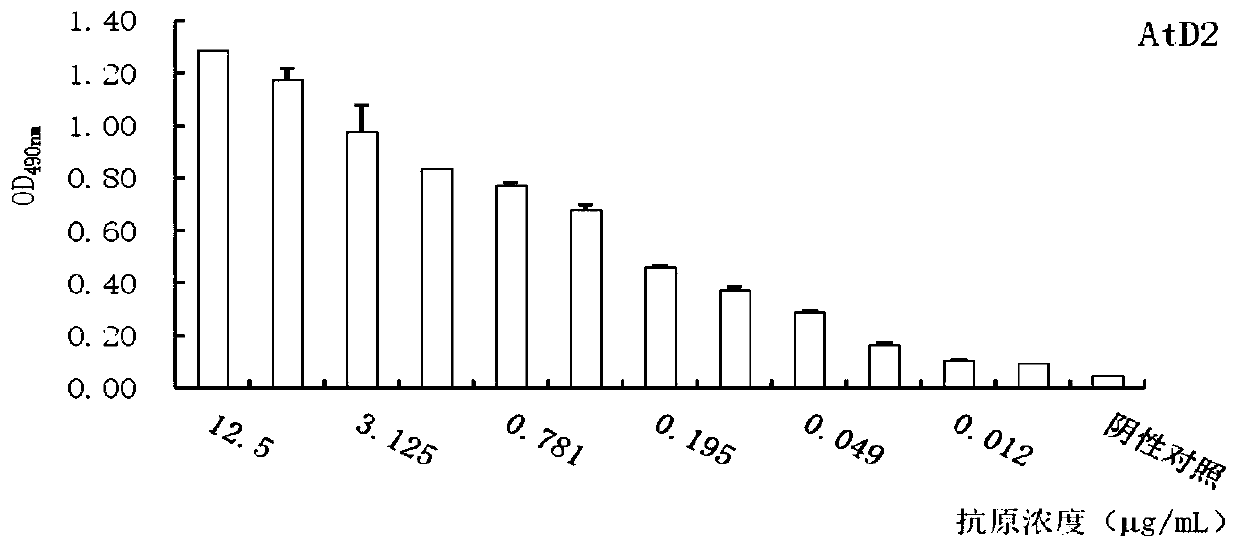Monoclonal antibody for identifying alternaria tenuissima, and hybridoma cell strain AtD2 of monoclonal antibody
A hybridoma cell line and monoclonal antibody technology, applied in the field of animals, can solve problems such as agricultural production losses, and achieve the effect of strong specificity and good development and application prospects
- Summary
- Abstract
- Description
- Claims
- Application Information
AI Technical Summary
Problems solved by technology
Method used
Image
Examples
Embodiment 1
[0018] Embodiment 1: Preparation of hybridoma cell lines
[0019] (1) Pick a single colony of Alternaria tenopolaris and inoculate them in potato dextrose liquid medium, shake and culture at 25°C for 4-5 days, collect spores and hyphae in a 50mL centrifuge tube, and centrifuge at 6000r / min for 20min , after washing twice with PBS, ultrasonic crushing (power 200W, crushing 2s, intermittent 2s), the crushed solution was centrifuged at 6000r / min for 20min, the supernatant was collected, and the supernatant protein content was measured by the Coomassie brilliant blue method, and the protein concentration was adjusted. 1000μg / mL, as the initial antigen for immunization antigen and later detection, the antigen solution was aliquoted in a small amount and stored in a freezer at -80°C. Take a small amount and store at -20°C before use.
[0020] (2) Three healthy BaL b / c mice aged 10-12 weeks were selected and injected intraperitoneally with 200 μL of antigen emulsified with an equal ...
Embodiment 2
[0023] Embodiment 2: the production of monoclonal antibody
[0024] Take BaL b / c mice about 8 weeks old, inject 0.3mL pristane intraperitoneally, and inject 5-10×10 5 7-10 days after injection, the peritoneal cavity of the mouse was obviously swollen. The ascites was collected, centrifuged at 2000r / min for 3min, and the supernatant was collected, which was the ascitic monoclonal antibody. Monoclonal antibodies were purified by Protein A column chromatography and stored at -80°C. The monoclonal antibody prepared from the AtD2 cell line is a monoclonal antibody that can specifically recognize Alternaria tenugarius.
Embodiment 3
[0025] Example 3: Titer detection experiment of monoclonal antibody
[0026] Antibody titer was determined by indirect ELISA method. Dilute 1000 μg / mL Alternaria tenugarii antigen 1000 times with coating solution and coat the whole microplate plate (1 μg / mL), overnight at 4°C, let it adsorb to the wells of the polystyrene plate, wash with PBST After three times, it was blocked with skim milk for 60 min. Monoclonal antibody AtD was diluted 2 times and added to the coated wells, 100 μL was added to each well, 37°C, 1 h, washed three times with PBST, and horseradish peroxidase-labeled rabbit anti-mouse (Sigma Company) diluted 5000 times according to the instructions was added to 100 μL wells, 37 ℃1h, after washing with PBST, add OPD substrate chromogenic solution to develop color, use 50μL 2M H 2 SO 4 After terminating the reaction, read the OD with a microplate reader 490nm , To determine the titer of monoclonal antibody ascites with the ratio of negative to positive greater...
PUM
 Login to View More
Login to View More Abstract
Description
Claims
Application Information
 Login to View More
Login to View More - R&D
- Intellectual Property
- Life Sciences
- Materials
- Tech Scout
- Unparalleled Data Quality
- Higher Quality Content
- 60% Fewer Hallucinations
Browse by: Latest US Patents, China's latest patents, Technical Efficacy Thesaurus, Application Domain, Technology Topic, Popular Technical Reports.
© 2025 PatSnap. All rights reserved.Legal|Privacy policy|Modern Slavery Act Transparency Statement|Sitemap|About US| Contact US: help@patsnap.com



